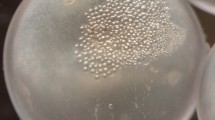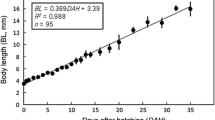Synopsis
Ghost pipefishes comprise a small family (Solenostomidae) of skin-brooding fishes related to true pipefishes and seahorses (Syngnathidae).Solenostomus embryos develop within the fused pelvic fins of the female, unlike syngnathids in which males brood the eggs. Embryos, enclosed in egg envelopes, are attached to epidermal stalks, termed cotylephores, that occur only in brooding females. Cotylephores are cellular outgrowths of the epithelium on the inside surface of the pelvic fins. They attain a mean length of 687 ± 3.89 μm and diameter of 105 ± 3.38 μm. Cotylephores originate on the epithelial surface that lies over the lepidotrichia and they develop into multi-headed cylindrical branches approximately 125 ± 3.65 μm in length and 78 ± 2.19 μm in diameter. A mean of 26 ± 0.63 lateral branches are found on fully developed cotylephores. Each branch terminates in a wide apical calyx, approximately 112 ± 4.16 μm in diameter, to which the egg envelope adheres. Adjacent calyces of the same cotylephore establish attachments with the envelope of a single egg. Cotylephores are composed of a surface epithelium that is continuous with the skin and a fibrous connective tissue core that contains blood vessels that ramify into an apical capillary plexus. The plexus may function in maternal-embryonic metabolic exchange. The cotylephores ofSolenostomus closely resemble the epidermal stalks (cotylephores) that are the sites of egg attachment in the skin-brooding South American catfish,Platystacus cotylephorus. Based on similarity in structure and probable function, cotylephores in the two groups of fishes are an example of evolutionary convergence.
Similar content being viewed by others
References cited
Balon, E.K. 1975. Reproductive guilds of fishes: a proposal and definition. J. Fish. Res. Board Can. 32: 821–864
Balon, E.K. 1981. Additions and amendments to the classification of reproductive styles in fishes. Env. Biol. Fish. 6: 377–389
Berglund, A., G. Rosenquist & I. Svensson. 1988. Multiple coatings and paternal brood care in the pipefish.Syngnathus typhle. Oikos 51: 184–188
Bertin, L. 1958. “Nidification”, pp. 1676–1677.In: P. Grasse(ed.) Traite de Zoologie, Vol. 13, Fascicule II. Masson and Co., Paris
Bloch, M.E. 1794. Naturgeschichte der auslandische Fische, achter Theil. J. Moreno & Co., Berlin. 486 pp
Breder, C.M. Jr. & D.E. Rosen. 1966. Modes of reproduction in fishes. Natural History Press, Garden City. 941 pp
Burgess, W.E. 1989. An atlas of freshwater and marine catfishes. T.F.H. Publications, Neptune City. 303 pp
Clutton-Brock, T.H. 1991. The evolution of parental care. Princeton University Press, Princeton. 352 pp
Fahmy, A. 1967. An extemporaneous lead citrate stain for electron microscopy. Proc. Annu. Meet. Electron Microsc. Soc. Am. 25: 148
Fishelson, L. 1966.Solenostomus cyanopterus Bleeker (Teleostei, Solenostomidae) in Elat (Gulf of Akaba). Israel J. Zool. 15: 95–103
Günther, A.C.L.G. 1880. An introduction to the study of fishes. Adam & Charles Black Publ., Edinburgh. 720 pp
Hyatt, M.A. 1986. Basic techniques for transmission electron microscopy. Academic Press, San Diego. 411 pp
Huot, A. 1902. Recherches sur les poissons lophobranches Ann. Sc. Nat. (Zool) 8 14: 197–288
Kaup, J.J. 1856. Catalogue of lophobranchiate fish in the collection of the British museum. Taylor & Francis London. 76 pp
Kuiter, R.H. 1993. Coastal fishes of South-eastern Australia. Univ. Hawaii Press, Honolulu. 437 pp
Leis, J.M. & T. Trnski. 1989. The larvae of Indo-Pacific shorefishes. University of Hawaii Press, Honolulu. 371 pp
Linton, J.R. & B.L. Soloff. 1964. The physiology of the brood pouch of the male seahorse,Hippocampus erectus. Bull. Mar. Sci. 14: 45–61
Mourier, J.P. 1970. Structure fine du rein de l'epinoche (Gasterosteus aculeatus L.) au cours de sa transformation Muqueuse. Z. Zellforsch. 106: 232–250
Orr, J.W. & R.A. Fritzsche. 1993. Revision of the ghost pipefishes, family Solenostomidae (Teleostei: Syngnathoidei). Copeia 1993: 168–182
Padmanabhan, K.G. 1961. Early development ofSolenostomus cyanopterus Bleeker. Bull. Central Res. Inst. Univ. of Kerala, series C (Nat. Sci.): 8: 1–14
Playfair, R.L. & A.C.L.G. Günther. 1866. The fishes of Zanzibar. John Van Voorst, London. 153 pp
Satchell, G.H. 1991. Physiology and form of fish circulation. Cambridge University Press, Cambridge. 235 pp
Schultz, L.P. 1953. Fishes of the Marshall and Marianas islands, vol. 1. Bull. U.S. National Museum 202: 1–685
Tsujii, T. & S. Seno. 1990. Melano-macrophage centers in the aglomerular kidney of the sea horse (teleosts): morphologic studies on its formation and possible function. Anat. Record 226: 460–470
Weber, M. & L.F. De Beaufort.1992. The fishes of the Indo-Australian Archipelago, vol. 4. E.J. Brill Publisher, Leiden. 410 pp
Wetzel, J. & J.P. Wourms. 1991. Paternal-embryonic relationships in seahorses and pipefishes (Syngnathidae). Amer. Zool. 31: 83A
Whitear, M. 1986. The skin of fishes including cyclostomes: epidermis; dermis. pp. 8–65.In: J. Bereiter-Hahn, A.G. Matoltsky & K.S. Richards (eds.) Biology of the Integument, vol. 2, Springer-Verlag, Berlin
Willey, A. 1910. The occurrance ofSolenostomus of the coast of Ceylon. Spolia Zeylanica 6: 102–107
Wourms, J.P. 1981. Viviparity: the maternal-fetal relationship in fishes. Amer. Zool. 21: 473–515
Wourms, J.P. & D.M. Cohen. 1975. Trophotaeniae; embryonic adaptations in the viviparous ophidioid fish,Oligopus longhurstii: a study of museum specimens. J. Morph. 147: 385–401.
Wourms, J.P., B.D. Grove & J. Lombardi. 1988. The maternal-embryonic relationship in viviparous fishes. pp. 1–134.In: W.S. Hoar & D.J. Randall (eds.) Fish Physiology, vol. 11B, Academic Press, San Diego
Wourms, J.P. & J. Lombardi. 1992. Reflections on the evolution of piscine viviparity. Amer. Zool. 32: 276–293
Wourms, J.P. & J. Wetzel. 1992. Evolutionary morphology of cotylephores: egg attachment sites in skin-brooding fishes. Amer. Zool. 32 (5): 160A
Wyman, J. 1859. On some unusual modes of gestation. Amer. J. Sci. 77: 5–13
Author information
Authors and Affiliations
Rights and permissions
About this article
Cite this article
Wetzel, J., Wourms, J.P. Adaptations for reproduction and development in the skin-brooding ghost pipefishes,Solenostomus . Environ Biol Fish 44, 363–384 (1995). https://doi.org/10.1007/BF00008252
Received:
Accepted:
Issue Date:
DOI: https://doi.org/10.1007/BF00008252




